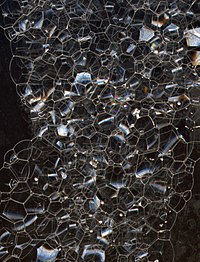
Photo from wikipedia
Phenolic foam composites (PFs) are of substantial interest due to their uniform closed-cell structure, low thermal conductivity, and good thermal insulation performance. However, their disadvantages of a high pulverization rate… Click to show full abstract
Phenolic foam composites (PFs) are of substantial interest due to their uniform closed-cell structure, low thermal conductivity, and good thermal insulation performance. However, their disadvantages of a high pulverization rate and poor mechanical properties restrict their application in building exterior insulation. Therefore, the toughening of these composites is necessary. In this paper, poplar fiber was treated with an acetylation reagent, and the acetylated fiber was used to prepare modified phenolic foams (FTPFs); this successfully solved the phenomenon of the destruction of the foam structure due to the agglomeration of poplar fiber in the resin substrate. The foam composites were comprehensively evaluated via the characterization of their chemical structures, surface morphologies, mechanical properties, thermal conductivities, and flame retardant properties. It was found that the compressive strength and compressive modulus of FTPF-5% respectively increased by 28.5% and 37.9% as compared with those of PF. The pulverization ratio was reduced by 32.3%, and the thermal insulation performance and flame retardant performance (LOI) were improved. Compared with other toughening methods for phenolic foam composites, the phenolic foam composites modified with surface-compatibilized poplar fiber offer a novel strategy for the value-added utilization of woody fiber, and improve the toughness and industrial viability of phenolic foam.
Journal Title: Materials
Year Published: 2019
Link to full text (if available)
Share on Social Media: Sign Up to like & get
recommendations!